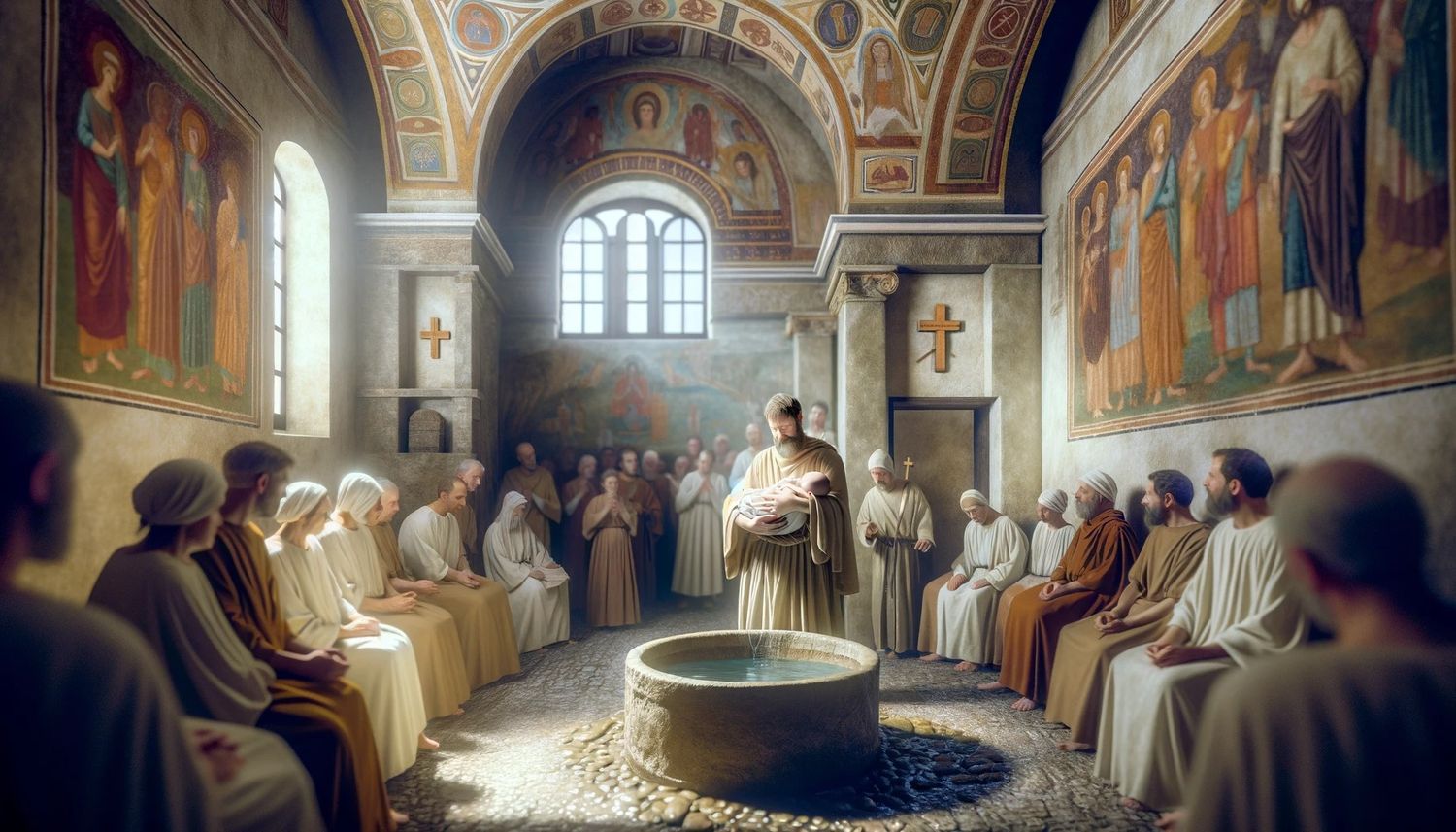Home>Theology and Spirituality>When Did Infant Baptism Begin?


Theology and Spirituality
When Did Infant Baptism Begin?
Published: March 2, 2024
Peter Smith, Editorial Director at Christian.net, combines deep insights into faith, politics, and culture to lead content creation that resonates widely. Awarded for his contributions to religious discourse, he previously headed a major organization for religious communicators, enhancing dialogue on faith's societal impacts.
Discover the origins of infant baptism and its significance in theology and spirituality. Explore the history and beliefs behind this sacred practice.
(Many of the links in this article redirect to a specific reviewed product. Your purchase of these products through affiliate links helps to generate commission for Christian.net, at no extra cost. Learn more)
Table of Contents
Origins of Infant Baptism
Infant baptism, the practice of baptizing babies or young children, has been a subject of debate and discussion within Christian traditions. The origins of infant baptism can be traced back to the early days of Christianity, with evidence suggesting that the practice may have been in existence as early as the 2nd century. The reasons for the emergence of infant baptism are multifaceted and are rooted in the cultural, theological, and social context of the time. Here are some key points to consider when exploring the origins of infant baptism:
-
Jewish Rituals and Practices: The early Christian community was heavily influenced by its Jewish roots, and the concept of ritual purification and initiation was integral to Jewish religious practices. Circumcision, for example, was a significant rite of passage for Jewish male infants. This cultural backdrop likely contributed to the acceptance of infant baptism as a parallel rite of initiation within the Christian community.
-
Household Baptisms: The New Testament contains references to the baptism of entire households, as opposed to individual adults. This has led some scholars to speculate that infant baptism may have been practiced within these early Christian households, where entire families, including infants and young children, were baptized together.
-
Early Church Fathers: The writings of early church fathers, such as Origen and Tertullian, provide insights into the evolving practices of baptism within the early Christian community. While their views on infant baptism varied, their writings indicate that the practice was being discussed and implemented within certain Christian circles.
-
Desire for Salvation: The belief in the necessity of baptism for the remission of sins and the attainment of salvation was a driving force behind the practice of infant baptism. Early Christians, influenced by the teachings of the apostles and the evolving theological landscape, sought to ensure the spiritual well-being of their children through the sacrament of baptism.
-
Cultural and Social Context: The societal norms and expectations of the Greco-Roman world, where Christianity was taking root, also played a role in the development of infant baptism. The idea of securing a child's place within the Christian community and protecting them from spiritual harm would have been compelling factors for the practice.
The origins of infant baptism are complex and multifaceted, and they reflect the diverse influences and considerations that shaped early Christian practices. While the exact moment of its inception may remain a point of scholarly debate, the emergence of infant baptism can be understood within the broader context of the early Christian community's beliefs, practices, and cultural milieu.
Read more: When Did Sprinkling For Baptism Begin
Early Christian Practices
The early Christian community grappled with the question of how to incorporate new members, including infants and young children, into the fold of the burgeoning faith. This period witnessed the development of various practices and rituals, including baptism, as a means of initiation and incorporation into the community of believers. Several key factors and practices shaped the early Christian approach to baptism, shedding light on the emergence of infant baptism within this context:
-
Household Baptisms: The New Testament contains accounts of household baptisms, where entire families were baptized together. This collective approach to baptism, which included individuals of all ages within a household, suggests that infants and young children may have been included in the early Christian practice of baptism.
-
Ritual Purification: The concept of ritual purification and initiation was deeply ingrained in the religious traditions of the time, particularly within the Jewish context. This cultural backdrop likely influenced the early Christians' understanding of baptism as a rite of initiation, leading to the inclusion of infants and young children in the baptismal process.
-
Desire for Spiritual Well-being: The early Christian community held a fervent belief in the salvific power of baptism, viewing it as essential for the remission of sins and the attainment of spiritual rebirth. This belief extended to infants, as parents and guardians sought to secure the spiritual well-being of their young ones through the sacrament of baptism.
-
Evolving Theological Landscape: The theological discussions and debates within the early Christian community also contributed to the development of baptismal practices. As the understanding of baptism evolved, so did the question of who should be the recipients of this sacrament. This theological reflection likely played a role in the inclusion of infants in the practice of baptism.
-
Cultural and Social Context: The societal norms and expectations of the Greco-Roman world, where Christianity was taking root, also influenced early Christian practices. The desire to ensure the inclusion and protection of children within the Christian community would have been a significant consideration in the decision to include infants in the baptismal rites.
The early Christian practices surrounding baptism, influenced by cultural, theological, and social factors, set the stage for the emergence of infant baptism within the Christian tradition. These practices reflect the community's efforts to navigate the complexities of incorporating individuals of all ages into the faith, laying the groundwork for the ongoing discussions and developments related to infant baptism.
Theological Debates and Developments
The emergence of infant baptism within the early Christian community sparked theological debates and developments that continue to shape Christian beliefs and practices to this day. The theological discourse surrounding infant baptism encompassed a range of perspectives, with scholars, theologians, and church leaders offering diverse insights and interpretations. Here are some key aspects of the theological debates and developments related to infant baptism:
-
Nature of Sin and Salvation: Central to the theological debates on infant baptism was the understanding of the nature of sin and the means of salvation. The belief in the inherited nature of sin, stemming from the doctrine of original sin, influenced the rationale behind baptizing infants. Proponents of infant baptism argued that it was essential for the remission of this inherited sin and the bestowal of God's grace upon the child.
-
Covenant Theology: The theological framework of covenant theology played a significant role in shaping the discussions on infant baptism. Within this framework, the covenantal relationship between God and His people, extending to their children, was seen as a basis for including infants in the sacrament of baptism. This perspective emphasized the continuity of God's covenant with the inclusion of children in the community of faith.
-
Age of Accountability: The theological concept of the "age of accountability" was a point of contention in the debates on infant baptism. Some theologians argued that individuals should reach an age of understanding and personal faith before receiving baptism, while others contended that the grace of baptism could be extended to infants, ensuring their spiritual well-being from an early age.
-
Biblical Interpretation: The interpretation of biblical passages related to baptism, such as the household baptisms in the New Testament and the teachings of Jesus on children, was a focal point in the theological debates. Different theological traditions approached these scriptural references from varying perspectives, contributing to the diversity of theological views on infant baptism.
-
Ecclesiological Considerations: The theological discussions on infant baptism also delved into ecclesiological considerations, addressing the nature of the church and its membership. The inclusion of infants in the sacrament of baptism was linked to the understanding of the church as a community encompassing individuals of all ages, with baptism serving as an entry into this communal identity.
The theological debates and developments surrounding infant baptism reflect the rich tapestry of theological reflection within the Christian tradition. While these discussions have at times led to divergent theological positions and denominational differences, they underscore the profound significance of infant baptism as a subject of theological inquiry and spiritual discernment.
Adoption by the Roman Catholic Church
The adoption of infant baptism by the Roman Catholic Church represents a significant development in the history of Christian sacramental practices. As the early Christian community grappled with theological debates and cultural influences, the Roman Catholic Church played a pivotal role in formalizing and institutionalizing the practice of baptizing infants. Several key factors contributed to the adoption of infant baptism within the Roman Catholic tradition, shaping its theological, liturgical, and pastoral dimensions.
-
Sacramental Theology: The Roman Catholic Church's sacramental theology, rooted in the belief in the efficacy of sacraments for the bestowal of God's grace, provided a theological foundation for the inclusion of infants in the sacrament of baptism. The understanding of baptism as a means of spiritual regeneration and incorporation into the body of Christ underscored the significance of infant baptism within the Roman Catholic tradition.
-
Catechetical Practices: The development of catechetical practices within the Roman Catholic Church also influenced the adoption of infant baptism. The emphasis on catechesis, or religious instruction, as a lifelong process of faith formation led to the recognition of infant baptism as the initial step in a child's journey of Christian initiation, with ongoing catechesis supporting their growth in the faith.
-
Pastoral Care: The pastoral considerations within the Roman Catholic Church played a crucial role in the adoption of infant baptism. The desire to ensure the spiritual well-being of infants and young children, coupled with the pastoral care provided by the Church, led to the formalization of infant baptism as a means of welcoming children into the Christian community and nurturing their faith from an early age.
-
Historical Precedents: The historical precedents within the Roman Catholic Church, including the practices of early Christian communities and the writings of church fathers, contributed to the adoption of infant baptism. The continuity of tradition and the recognition of infant baptism as a longstanding practice within certain Christian circles influenced the Roman Catholic Church's embrace of this sacramental rite.
-
Ecclesial Authority: The role of ecclesial authority and magisterial teachings within the Roman Catholic Church also played a significant part in the adoption of infant baptism. The formal pronouncements and decrees of church councils and authoritative documents affirmed the practice of baptizing infants, solidifying its place within the liturgical and sacramental life of the Roman Catholic Church.
The adoption of infant baptism by the Roman Catholic Church reflects the intersection of theological, pastoral, and historical considerations within the development of Christian sacramental practices. This adoption has contributed to the rich tapestry of Roman Catholic liturgical and sacramental life, shaping the faith journeys of countless individuals within the Catholic tradition.
Spread to Other Christian Traditions
The practice of infant baptism, which originated within the early Christian community and was adopted by the Roman Catholic Church, subsequently spread to other Christian traditions, contributing to the diverse landscape of baptismal practices within Christianity. The diffusion of infant baptism to other Christian traditions was influenced by a combination of historical, theological, and cultural factors, leading to its incorporation into the liturgical and sacramental life of various denominations. Here are some key aspects of the spread of infant baptism to other Christian traditions:
-
Historical Dissemination: The historical dissemination of infant baptism, facilitated by the expansion of Christianity to different regions and communities, contributed to its adoption by a wide array of Christian traditions. As the Christian faith spread geographically, the practice of infant baptism accompanied this diffusion, becoming integrated into the worship and spiritual life of diverse Christian communities.
-
Theological Reflection: The theological reflection on baptism, including infant baptism, within the early Christian church and subsequent theological developments within various Christian traditions, played a pivotal role in the spread of this practice. The theological considerations surrounding the nature of baptism, the role of children within the faith community, and the understanding of sacramental grace influenced the reception of infant baptism within different theological contexts.
-
Liturgical Adaptation: The adaptation of liturgical practices, including the sacrament of baptism, within different Christian traditions contributed to the spread of infant baptism. As Christian communities developed their distinct liturgical expressions and worship traditions, the inclusion of infant baptism became a defining feature of their sacramental life, reflecting the broader acceptance of this practice within the Christian faith.
-
Cultural Context: The cultural context within which Christian communities existed also played a significant role in the spread of infant baptism. Cultural norms, societal expectations, and familial traditions influenced the reception and perpetuation of infant baptism within diverse cultural settings, contributing to its integration into the religious practices of different Christian traditions.
-
Ecclesial Diversity: The ecclesial diversity within Christianity, encompassing a wide spectrum of denominations, traditions, and theological emphases, provided a varied landscape for the spread of infant baptism. Different Christian traditions, including Eastern Orthodox, Anglican, Lutheran, and Reformed traditions, embraced infant baptism within their respective ecclesial contexts, contributing to its widespread presence across denominational lines.
The spread of infant baptism to other Christian traditions reflects the dynamic and multifaceted nature of Christian sacramental practices, encompassing historical, theological, liturgical, cultural, and ecclesial dimensions. This diffusion has contributed to the rich diversity of baptismal practices within Christianity, highlighting the enduring significance of infant baptism as a shared sacramental heritage across various Christian traditions.















